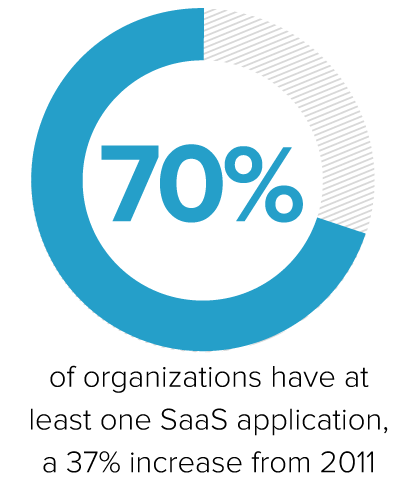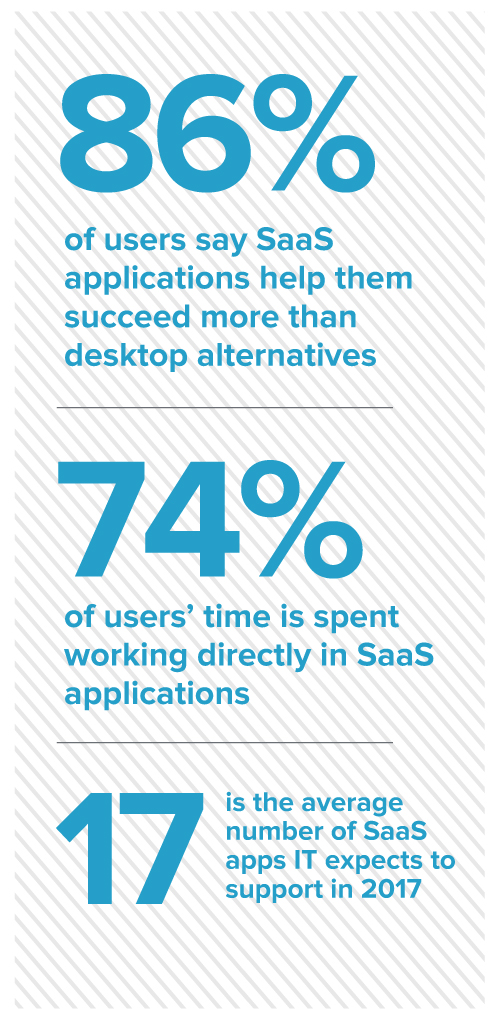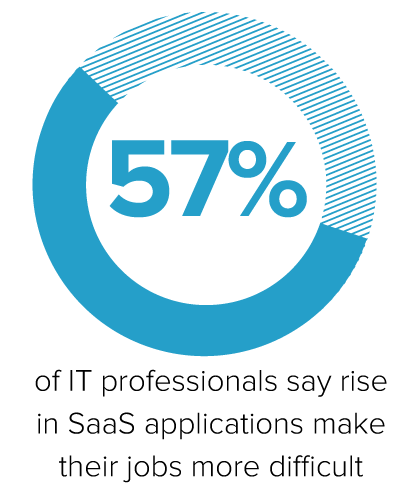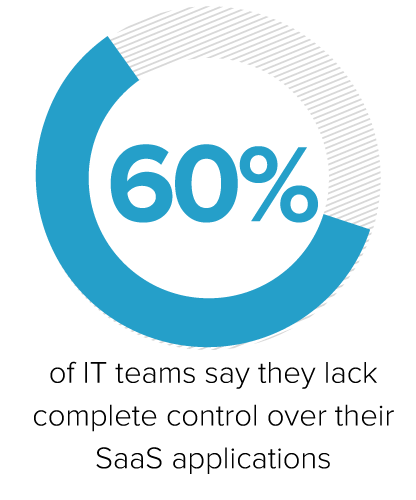The SaaS-Powered Workplace: The Present & Future of Work
December 6, 2016
5 minute read

Today, BetterCloud is introducing the first-ever multi-SaaS management platform. Reading this post in full will help explain why this is the most significant announcement in BetterCloud history. Skip down to the multi-SaaS management section of this post to learn more about the new platform.
In 2011, inventor, entrepreneur, and investor Marc Andreessen famously wrote, “Software is eating the world.” Five years have passed and software’s appetite is more insatiable than ever.
Every day, hundreds of millions of people go to work and use software delivered as a service. CEOs, developers, IT, and everyone in between rely on SaaS applications to do their jobs.
They’re fundamental business assets.
Cornerstones.
Building blocks for the modern-day company.
Today, SaaS plays an indispensable role for startups and multi-billion dollar businesses alike. And when it comes to advancements in enterprise technology, SaaS and innovation have become nearly synonymous.


We Live in the Age of the SaaS-Powered Workplace
Today’s CEOs and CIOs aren’t poring over blueprints titled, “Server Room Expansion Plan.”
Instead, they’re reading how-to books and meeting consultants in conference rooms to plan the replacement of legacy applications with SaaS alternatives. That’s why digital transformation is the fastest-growing practice for many consulting companies around the world.
The SaaS-Powered Workplace is a worker’s dream. It’s a workplace that enables employees to use the best technology available to them.
From a business perspective, there are several simple reasons why the SaaS-Powered Workplace is becoming the dominant way to work. SaaS applications are:
- Highly collaborative. Best-of-breed SaaS applications enable real-time collaboration across teams and time zones, minimizing traditional back-and-forth in ways on-prem applications never could.
- Incredibly mobile. Whether you’re 30,000 feet in the air or in the back of a taxi, SaaS applications give employees the flexibility to work when and where they want.
- Simple to use. SaaS applications are intuitive, built with a focus on design and user experience. SaaS applications are light years ahead of on-prem applications in terms of simplicity. It’s like learning to fly a kite versus learning to fly a plane.
- Productivity powerhouses. 86% of users say SaaS applications help them succeed more than desktop alternatives, according to our 2016 Trends in Cloud IT survey. SaaS has already smashed through the boundaries of possibility and forever altered the way we work, and we’ve only just scratched the surface.

There’s a reason on-prem is often referred to as legacy technology. For most companies, SaaS technology is the present and future of work.
The SaaS-Powered Workplace has Forever Changed IT
There has never been a more exciting time to work in IT. Today’s opportunities and challenges are unlike any the industry has ever faced.
The SaaS-Powered Workplace has put IT at the forefront of a workplace reinvention. The department that was once relegated to back-office work and labeled a cost-center is now the compass, the sherpas of success.
IT is in the driver’s seat, and they aren’t steering a caravan. They’re behind the wheel of a SaaS-powered racecar.
But the road ahead isn’t all sunshine and daisies. It’s littered with unexpected turns and canyon-like potholes.

While sales, marketing, finance, support, engineering, and all the other departments reap the rewards of SaaS applications (without drawbacks), IT experiences the growing pains.
In the SaaS-Powered Workplace, IT must manage and secure a complex hodge-podge of technology. And as the saying goes, “Complexity is the enemy of security.”
When IT is facing ever-growing checklists, constantly tabbing from dashboard to dashboard to perform manual tasks, data slips through the cracks. Sensitive financial figures fall into the wrong hands.
Employees are granted the wrong permissions, leading to disastrous and irreversible mishaps. Licenses go unused, and thousands, even millions of dollars, are thrown out the window.
IT needs visibility and control to solve these problems, and that’s precisely what they lack. Without visibility, IT can’t make informed decisions. Without control, they can’t take action.
Without either, they can’t do their jobs. It’s that simple.


Multi-SaaS Management: The Next Evolution of IT
It’s become clear, given the unprecedented lack of control and visibility, that IT needs a solution–if not an entirely new approach to IT.
Enter multi-SaaS management, an IT approach fit for SaaS-Powered Workplace.
Multi-SaaS management is a centralized way to manage, operationalize, and automate SaaS administration across applications.
The core principles of multi-SaaS management are:
- Centralize. In the SaaS-Powered Workplace, IT needs an administrative destination–a command center capable of ingesting information and replicating (even amplifying) the capabilities of admin consoles for various applications.
- Automate. All of today’s SaaS applications require manual administration. As the SaaS-Powered Workplace grows, manual work compounds until it consumes the workday. IT must seek to streamline manual tasks to ensure accuracy, precision, and compliance.
- Govern. When auditing applications, users, files, privileges, and policies, IT needs contextual, cross-app insights, which are next to impossible to find when manually searching for problems in each application. The SaaS-Powered Workplace also requires intelligent alerting on operational risks and exposures. Instead of just make IT aware of a problem, it offers a solution–in some cases even remediating the issue automatically.
BetterCloud, The First-Ever Multi-SaaS Management Platform
For two years, BetterCloud has undergone a ground-up reconstruction to build a platform that is purpose-built for IT management in the age of the SaaS-Powered Workplace.
Today, we are announcing our new multi-SaaS management platform and integrations with our technology partners: G Suite, Slack, Dropbox, and Zendesk–with more to come in early 2017.
The new BetterCloud is built on the core principles of multi-SaaS management and gives IT the ability to:
- Centralize information and merge SaaS accounts to create comprehensive user profiles. This gives IT an unprecedented view, far beyond identity, to show each user’s apps, permissions, groups, files, and more.
- Streamline user lifecycle management by creating customizable, cross-app workflows that trigger based on changes in BetterCloud or external systems, such as the Google Admin Console, Active Directory, or SSO solutions.
- Manage privileged access and user roles across applications, ensuring users and your IT team have access to what they need and nothing more.
- Create actionable alerts for policy violations, inactive user accounts and more–all of which are fixable with a single click or the creation of a repeatable and automated workflow.
- Evaluate risks by auditing shared documents, apps, usage patterns, files, and more to identify and remediate security issues.
SaaS Applications Will Continue to Steer the Future of Work
As Andreessen stated in 2011, “More and more major businesses and industries are being run on software and delivered as online services—from movies to agriculture to national defense.”
SaaS adoption shows no signs of slowing. The SaaS market will grow to $216 billion in 2020, more than double its current size, according to Gartner.
And rightly so.
Without SaaS applications, thousands of companies would cease to exist. Thousands more would literally break down. Millions of employees would instantly be less productive or lose their jobs.
Without SaaS, there’d be no mobile workforce. No real-time collaboration or video conferencing.
Without SaaS, the world would be different. And without IT, it wouldn’t be possible.






